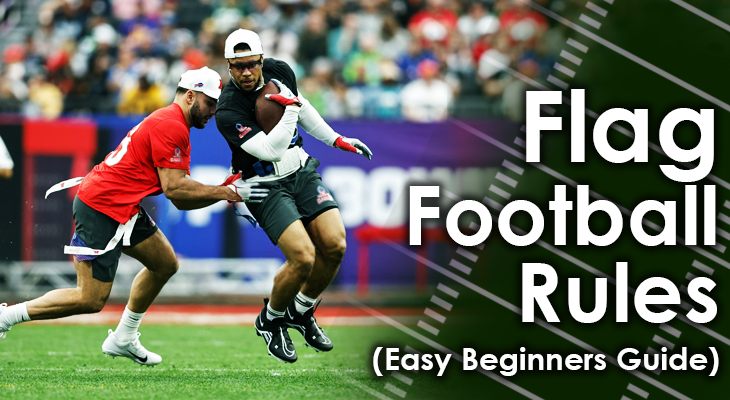Flag football has become more and more popular in recent years.
And that's a good thing.
It doesn't have any of the hard-hitting tackles regular football does, which protects younger bodies from the wear and tear of the game.
Flag football is more about agility and endurance than toughness and durability. So it's a great way to help kids learn skills while having fun.
It's become so popular today that the NFL sanctions leagues around the United States with a standard set of rules and best practices.
If you're interested in "Flag" or starting up a new league, below we'll give you an overview of the flag football rules to help you get started.
Flag Football Rules Overview
Flag football rules can vary a lot since there are so many different leagues.
While NFL Flag Football is an official organization with standard rules -- much like "Little League" in baseball -- there are many other leagues with their own version of the rules who don't have an affiliation with such a large organization.
That being said, most flag football leagues will have the same general rules as each other.
So if you're going to coach in an existing league, use this guide as a way to learn the basic rules... but make sure you cross-reference with your league's specific rule book in case there are any deviations.
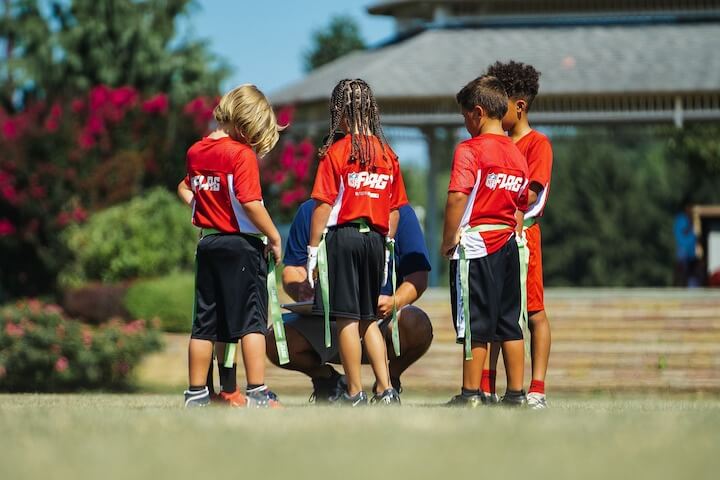
Flag Football vs. Tackle Football
The biggest difference between flag football rules and regular tackle football rules is how they handle contact.
In tackle football, there is a lot of physical contact. Players wear a full set of protective gear -- everything from thigh pads, to shoulder pads to a helmet with a face mask -- to protect them. All this is necessary since players will block and hit each other, and the only way to bring a play to an end is to tackle a ball carrier to the ground.
Flag football however, bans all contact except hand checking.
So players don't wear any pads at all.
Players make "tackles" by ripping a belt off a player's waist or one of the flags attached to the waist. This is where flag football gets its name.
Since there are no pads and only one offensive lineman, flag football allows youth players to learn the skilled positions of the game more easily. This helps them prep and refine their skills for when they might play tackle football in the future.
How Flag Football Works:
Just like in tackle football, all flag football games start with a coin toss.
There is no kickoff, though. The team that "receives" the ball -- or that starts on offense -- will begin the drive from their own 5-yard line.
They'll have four downs to cross midfield. If they're able to do so, they'll gain a first down and get three more downs to try to score.
After three downs, if the offense hasn't crossed midfield, then there are two things they can do.
1. "Punt"
They won't actually kick the ball away like in tackle football, though.
Instead, they’ll just give the ball to the other team, whose offense will start from their own five-yard line.
2. Go for it on 4th down
If they are able to cross midfield, then they gain a first down.
If they fail to do that, though, the other team will take over possession of the ball from the spot of where the last play ended.
Flag Football Equipment:
Here's a basic list of flag football equipment every player needs:
They won't wear traditional pads and protective gear, but rather…
Shorts: All players will wear shorts that don't have any pockets in them, to prevent against penalties and injuries to their hands/fingers.
Mouthguard: While there aren't any pads, they still need mouth guards to protect against head and mouth injuries.
Cleats: All players will wear cleats while on the field, though most leagues ban metal cleats due to the potential injuries they may cause.
Gloves: Some players may choose to wear gloves -- it isn't a required piece of equipment, but very helpful.
Belt and Flags: This is the key piece of equipment in flag football. All players will wear a belt around their waist with a several plastic flags hanging off it. A player gets tackled when a member of the other team either rips one of the flags off their belt, or rips their belt off completely.
Players on a Flag Football Team:
The roster construction is perhaps the biggest variance in flat football rules from one league to the next.
Some leagues go as small as 5-on-5.
In this instance, each offense consists of a center, quarterback, and some combination of three wide receivers and running backs.
Defenses will counter with two defensive backs, two safeties, and one rusher.
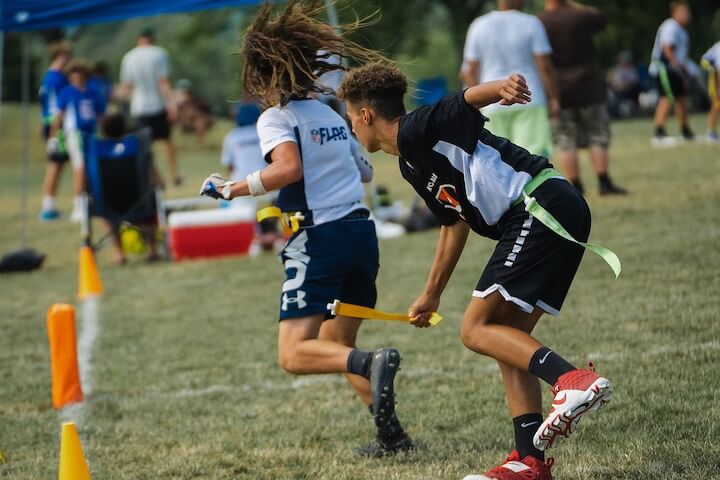
Flag Football Positions:
5-on-5 Offensive Positions
Center
The center is the only "offensive lineman" on the field.
He's responsible for snapping the ball, which starts each new play.
He can either do so in the shotgun formation (the most common in flag football) or while the quarterback is under center.
Unlike in tackle football, centers are eligible to run passing routes and catch passes.
Quarterback
This position is similar to tackle football.
The quarterback gets the snap from the center, and then either passes to one of his receivers or hands it off to a running back.
Most flag football leagues prohibit quarterbacks from attempting QB keepers. However, leagues with larger starting lineups - such as 7-on-7 - may allow this.
Wide Receiver / Running Back
Any player who's not a QB or center will fit into the WR/RB category.
They line up either at the line of scrimmage or in the backfield, and are eligible to catch a pass or take a handoff.
5-on-5 Defensive Positions
Defensive Back
These players will line up closest to the line of scrimmage.
They're responsible for covering the short passes and also any runs toward the outside of the field.
Safety
A safety will line up further off the line of scrimmage.
They'll pick up any receiver who breaks free from a defensive back.
Since they line up off the LOS, they can look for the run first, and then adjust to the pass.
Rushers
Rushers are the only players who can try to blitz the quarterback.
They have to start the play lined up at least seven yards off the LOS.
They don't have to rush the quarterback but can.
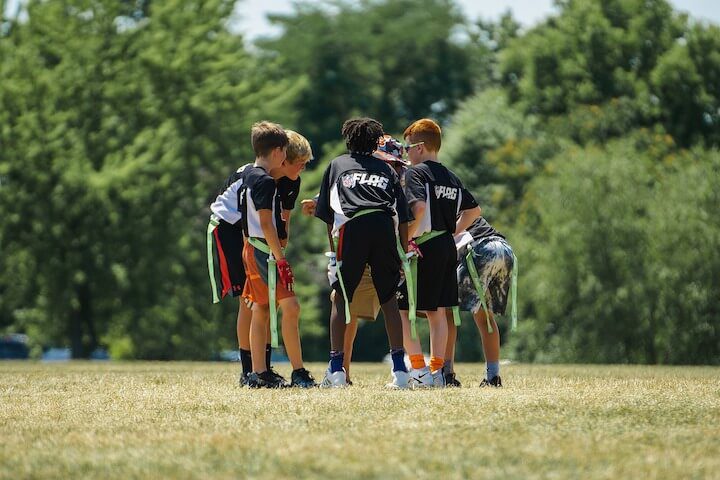
Scoring in Flag Football:
There is no "kicking game" in flag football, which makes the scoring slightly different than tackle football.
There are only four ways to score points:
Touchdown - Any touchdown is worth 6 points, just like in tackle football
1-Point Conversion - Following a touchdown, the offense can choose to attempt a 1-Point Conversion -- which is a regular offensive play run from the opponents' five-yard line.
2-Point Conversion - Following a touchdown, the offense can also choose to attempt a 2-Point Conversion. Again, this is a regular offensive play, but it's run from the opponents' 10-yard line instead.
Safety: Any safety the defense is able to record is worth 2 points.
Flag Football Field Size
Since there are fewer players in flag football, field are much smaller.
A tackle football field is 100 yards long, plus two 10-yard end zones.
A typical flag football field is 70 yards long x 30 yards wide.
The field is split into three different zones:
Two end zones that are 10 yards long, as well as a midfield line-to-gain.
On either side of these zones is usually a five-yard zone where offenses may NOT run the football - or what's known as "No Run Zones." When the offense starts a play in these NRZs, they may only call passing plays.
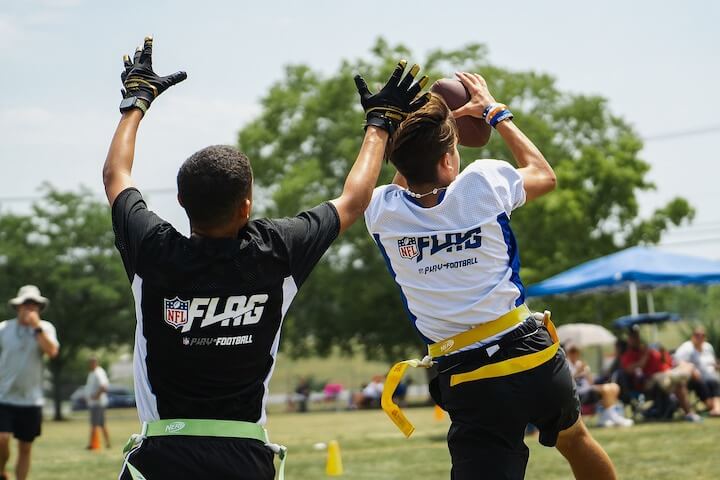
Unique Flag Football Rules
Passes
Every pass must be forward and caught in front of the line of scrimmage.
This means that all screens behind the LOS are banned.
Handoffs
Offenses can only hand the ball off directly to a running back.
There can't be any pitches or laterals -- anywhere on the field.
Likewise, quarterbacks are usually banned from running with the football.
Passing Clock
The quarterback will have seven seconds to throw the football on each play.
If he doesn't get rid of it by then, it's considered a sack.
Rusher
Each defensive team can have one rusher, who must line up at least seven yards off the line of scrimmage.
No offensive player can stand in this position's way as they rush the quarterback.
Penalties
Every offensive penalty called in flag football results in both a loss of yardage and a loss of down.
Every defensive penalty results in an automatic first down for the offense, and some penalties also award the offense yardage.
Contact
Almost all flag football leagues strictly prohibit contact.
Some more advanced and larger leagues will allow mild contact, but nothing serious since players aren't wearing pads or helmets.
7-on-7 Flag Football
Another common version of flag football is the 7-on-7.
This version is essentially what you'd get if you took the normal tackle football offense and removed all the offensive linemen except the center.
In most leagues, though, there will be a few offensive linemen on the field.
They won't block in the traditional sense -- where they use brute strength and leverage to protect the quarterback -- but will rather use angling and footwork to prevent rushers from getting into the backfield.
Most of the time, 7-on-7 flag football leagues are for older players who have some experience in the game.
That being said it's not a guarantee that all leagues will transition to 7-on-7 once the players age.
Conclusion
Flag football is increasing in popularity every year, and it's easy to see why.
It's a great way to get more people interested in playing the great game of football, without the need to spend a lot of money on pads and equipment. It also comes without the same risk of major injuries.
Flag football has opened the door to loads of kids to play the game of football that otherwise might not have access to it.
If you're new to the game, you can follow our Flag Football Rules Easy Beginner's Guide above to get you started.
Just make sure you check your league's specific rule book, though, as many leagues have different variations of rules and regulations.

